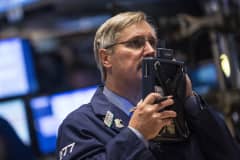It's beginning to look a lot like taper
Tuesday, 10 Dec 2013 | 7:04 AM ET
The Federal Reserve could begin to taper its bond purchases as early as next week, reports CNBC's Steve Liesman.
It increasingly appears that tapering is coming at the Fed's meeting next week.
While forecasting the central bank's moves has been an uncertain proposition for most of the past several months—with the conventional wisdom having it wrong in June and September—several of the Fed's own financial tests for reducing its asset purchases look to have been met as it heads into the Dec. 17 meeting. Those include confidence in the outlook, an easing of fiscal drag and uncertainty, and what the Fed sees as more appropriate interest rates.
While forecasting the central bank's moves has been an uncertain proposition for most of the past several months—with the conventional wisdom having it wrong in June and September—several of the Fed's own financial tests for reducing its asset purchases look to have been met as it heads into the Dec. 17 meeting. Those include confidence in the outlook, an easing of fiscal drag and uncertainty, and what the Fed sees as more appropriate interest rates.
To be sure, the Fed could decide to wait
another month for even greater clarity, and practically, many Fed
officials see little difference in a taper program that begins in
December versus January.
But it looks as if the three tests for tapering have nearly been met.
(Read more: Global economy might be comeback story of 2014)
Confidence in the outlook: As of Friday's jobs reports, three-month average job growth is 193,000, up by 44,000 compared with what the Fed knew about payroll growth in September, when it surprised markets by failing to taper. Job growth in three of the past four months has been above 200,000. At 7 percent, the unemployment rate is two-tenths lower than in September.
Add to that an easing of tension in Europe and growing household wealth with stock and real estate values higher, and the Fed has ample reason to feel better about the economy and the outlook than it did in late summer.
(Read more: Why the path to higher rates is unlikely to be smooth)
But it looks as if the three tests for tapering have nearly been met.
(Read more: Global economy might be comeback story of 2014)
Confidence in the outlook: As of Friday's jobs reports, three-month average job growth is 193,000, up by 44,000 compared with what the Fed knew about payroll growth in September, when it surprised markets by failing to taper. Job growth in three of the past four months has been above 200,000. At 7 percent, the unemployment rate is two-tenths lower than in September.
Add to that an easing of tension in Europe and growing household wealth with stock and real estate values higher, and the Fed has ample reason to feel better about the economy and the outlook than it did in late summer.
(Read more: Why the path to higher rates is unlikely to be smooth)
End of fiscal uncertainty:
Most Fed officials talk with increasing certainty about a pickup in
growth next year. Part of that confidence is simple math. They see the
effects of fiscal drag from government cutbacks easing next year and a
waning impact from the January rise in tax rates. The Fed said
explicitly in September that it was concerned about the negative effects
of a looming government shutdown. Its political forecasting turned out
to be on the mark (better, in fact, than its economic forecasting).
It now appears that congressional Democrats and Republicans are on the verge of a deal to put off another debilitating deficit debates for at least two years. That should give the Fed more confidence in the outlook even though fourth-quarter growth is expected to be in the 1 percent range.
(Read more: 'It is time to taper' says Fed's Fisher)
Interest rates: This is the one area that could yet sway the debate the other way, but on balance, it favors a tapering. The 10-year benchmark Treasury bond, at around 2.84, is pretty much where it was in September when the Fed said in its statement "tightening of financial conditions observed in recent months, if sustained, could slow the pace of improvement in the economy and labor market."
But there are some key differences. First, short rates have been far more well-behaved, indicating to Fed officials that markets embrace their notion that "tapering is not tightening,"—that is, reducing asset purchases should not bring forward the date when the market expects the Fed to hike interest rates. Indeed, the Fed Funds Futures contract for June 2015 traded as high as 92 basis points in September and 66 basis points the day before the September meeting. That same contract now trades at around 27 basis points.
Significantly, it did not move at all after Friday's surprisingly strong jobs report. The Fed takes this as the markets' belief in its pledge to keep rates "lower for longer" than would seem appropriate under normal economic conditions.
Second, the unemployment rate is lower, and third-quarter gross domestic product was revised up to 3.6 percent last week from the initial report of 2.8 percent. Fed officials are unlikely to fight hard against them if they perceive that they result from a better growth outlook.
It now appears that congressional Democrats and Republicans are on the verge of a deal to put off another debilitating deficit debates for at least two years. That should give the Fed more confidence in the outlook even though fourth-quarter growth is expected to be in the 1 percent range.
(Read more: 'It is time to taper' says Fed's Fisher)
Interest rates: This is the one area that could yet sway the debate the other way, but on balance, it favors a tapering. The 10-year benchmark Treasury bond, at around 2.84, is pretty much where it was in September when the Fed said in its statement "tightening of financial conditions observed in recent months, if sustained, could slow the pace of improvement in the economy and labor market."
But there are some key differences. First, short rates have been far more well-behaved, indicating to Fed officials that markets embrace their notion that "tapering is not tightening,"—that is, reducing asset purchases should not bring forward the date when the market expects the Fed to hike interest rates. Indeed, the Fed Funds Futures contract for June 2015 traded as high as 92 basis points in September and 66 basis points the day before the September meeting. That same contract now trades at around 27 basis points.
Significantly, it did not move at all after Friday's surprisingly strong jobs report. The Fed takes this as the markets' belief in its pledge to keep rates "lower for longer" than would seem appropriate under normal economic conditions.
Second, the unemployment rate is lower, and third-quarter gross domestic product was revised up to 3.6 percent last week from the initial report of 2.8 percent. Fed officials are unlikely to fight hard against them if they perceive that they result from a better growth outlook.
Jeff Rosenberg, chief investment strategist for fixed income at BlackRock,
said that the Fed's concern with higher long rates could keep a lid on
their levels, with investors unwilling to bid up rates too high for fear
that the Fed would act to tamp them down.
(Read more: Is Fed causing deflation? Some think so)
What's also clear is that several centrists on the rate-setting Federal Open Market Committee appear ready to discuss a taper, and some even have publicly called for a reduction. Notably, St. Louis Fed President Jim Bullard said Monday, "A small taper might recognize labor market improvement while still providing the committee the opportunity to carefully monitor inflation during the first half of 2014."
Atlanta Fed President Dennis Lockhart said last week that tapering should be discussed, and Jeff Lacker, president of the Richmond Fed, weighed in with similar comments Monday.
—By CNBC's Steve Liesman. Follow him on Twitter: @steveliesman
(Read more: Is Fed causing deflation? Some think so)
What's also clear is that several centrists on the rate-setting Federal Open Market Committee appear ready to discuss a taper, and some even have publicly called for a reduction. Notably, St. Louis Fed President Jim Bullard said Monday, "A small taper might recognize labor market improvement while still providing the committee the opportunity to carefully monitor inflation during the first half of 2014."
Atlanta Fed President Dennis Lockhart said last week that tapering should be discussed, and Jeff Lacker, president of the Richmond Fed, weighed in with similar comments Monday.
—By CNBC's Steve Liesman. Follow him on Twitter: @steveliesman


No comments:
Post a Comment